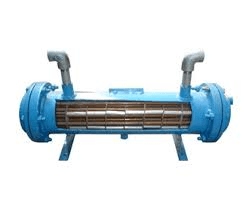Shell Tube Chiller Heat Exchangers:
Shell tube chillers heat exchanger is a class of heat exchanger designs. It is the most common type of heat exchanger in oil refineries and other large chemical processes, and is suited for higher-pressure applications. As its name implies, this type of heat exchanger consists of a shell a large pressure vessel with a bundle of tubes inside it. One fluid runs through the tubes, and another fluid flows over the tubes (through the shell) to transfer heat between the two fluids. The set of tubes is called a tube bundle, and may be composed of several types of tubes: plain, longitudinally finned.
Process:
Shell Tube chillers Heat Exchanger is built for efficient heat transfer from one fluid to another, whether the fluids are separated by a solid wall so that they never mix, or the fluids are directly contacted. Shell Tube chillers Heat Exchangers are widely used in petroleum refineries, chemical plants also it is used extensively in fossil-fuel and nuclear power plants, gas turbines, heating and air conditioning, refrigeration, and the chemical industry, textile mills evaporation and drying system. Numerically controlled drilling equipments are available to meet accuracy level specially of heavy duty drilling.
Image:

Features:
- Sturdy construction
- Low maintenance
- phase heat exchangers
- Two-phase heat exchangers can be used to heat a liquid to boil it into a gas
- Boilers in steam engine locomotives are typically large and usually cylindrically-shaped shell-and-tube heat exchangers
- In large power plants with steam-driven turbines, shell-and-tube surface condensers are used to condense the exhaust steam exiting the turbine into condensate water
- The condensate water can be recycled back to be turned into steam in the steam generator
Advantages:
- Condensation or boiling heat transfer can be accommodated in either the tubes or the shell, and the orientation can be horizontal or vertical. You may want to check out the orientation of the heat exchanger in our
laboratory. Of course, single phases can be handled as well. - The pressures and pressure drops can be varied over a wide range.
- Thermal stresses can be accommodated inexpensively.
- There is substantial flexibility regarding materials of construction to accommodate corrosion and other concerns. The shell and the tubes can be made of different materials.
- Extended heat transfer surfaces (fins) can be used to enhance heat transfer.
- Cleaning and repair are relatively straightforward, because the equipment can be dismantled for this purpose.
Applications:
Shell & Tube Heat Exchangers are most commonly used in almost all industries like- Refineries, Chemical plants, Fertilizer plants, Genset units, Oil & Gas and Shipping. Typical use of Heat Exchanger is to cool or heat the fluids or gases.

